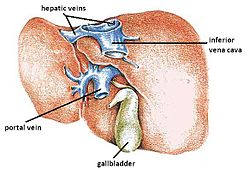Budd - Chiari syndrome
Budd-Chiari syndrome is characterized by an 'occlusion of the hepatic veins', which prevents the outflow of blood from the liver (into the v. Cava inferior ). This is a rare condition (1: 1,000,000).
Etiology[edit | edit source]
Hepatic venous occlusion occurs, for example, in "thrombosis" (may be related to the use of hormonal contraception), in "suppression by a tumor" (usually liver cancer), and in congenital malformations of the liver. In some cases, the cause is undetectable.¨
Symptoms[edit | edit source]
Accumulation of blood in the liver. The resulting overpressure is transmitted to the portal vein. Subsequently, "portal hypertension" arises with all its consequences (ascites, esophageal varices, etc.). Liver damage occurs, which can result in non-alcoholic cirrhosis.
Diagnosis[edit | edit source]
- Physical examination - see above, eg ascites,
- blood test - increased 'liver tests expressing liver tissue damage (AST, ALT),
- 'Ultrasound' or CT 'examination of the abdomen.
Treatment[edit | edit source]
During treatment, it depends most on the cause that caused the syndrome.
- In portal hypertension - diuretics and other drugs that reduce it,
- in thrombosis - 'anticoagulants' (eg warfarin),
- to ensure blood flow from the liver - transjugular intrahepatic portosystemic shunt ( 'TIPS' ),
- liver transplantation.
Links[edit | edit source]
Related articles[edit | edit source]
Source[edit | edit source]
- ŠTEFÁNEK, Jiří. Medicína, nemoci, studium na 1. LF UK [online]. ©2011. [cit. 14. 4. 2011]. <http://www.stefajir.cz/index.php?q=budd-chiariho-syndrom>.




